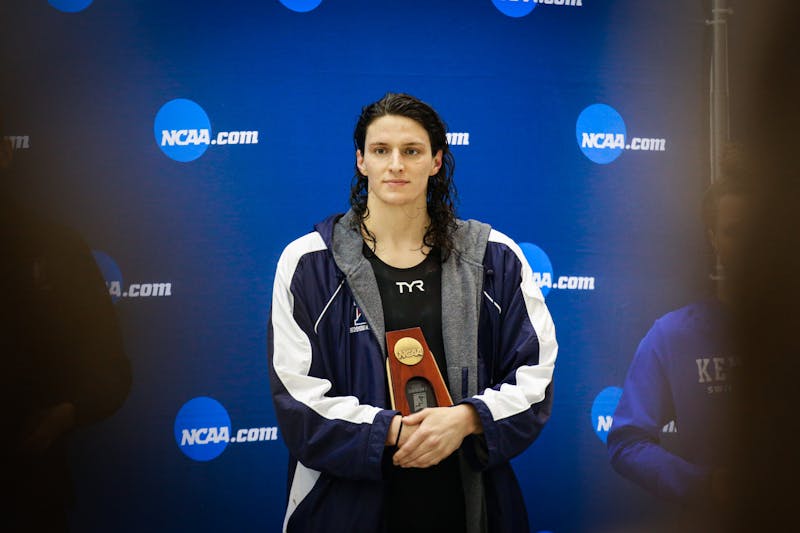
As he prepped for a long July drive down Route 66, Engineering junior Michael Balsamo was both nervous and psyched.
But it was not the scenery he would pass on his 2,300-mile trek from Chicago to Los Angeles that had him pumped.
It was the car he was driving.
Or, more specifically, the solar-powered racecar -- called 76 -- that he and a team of 20 other Penn students designed and built from scratch.
As the team has done every two years since it was founded in 1989, Balsamo and the rest of the Penn Solar Racing Team spent two weeks of last summer competing in the biennial American Solar Challenge.
"It was tense, and it was really a lot of fun at the same time," team leader Balsamo says of his first stint behind 76's wheel. "You hop in and say to yourself, 'Wow, I'm in a one-of-a-kind $80,000 vehicle.'"
Flat, square and covered with solar panels, 76 looks more like a UFO than a car, especially with its vision bubble protruding from the middle -- which allows the driver to see the road ahead as he lies down in the cramped driving space.
But to Balsamo and his teammates, the car represents much more than a vehicle -- it's the product of two years of brainstorming, designing and late-night building sessions.
And now, as the team begins the two-year process all over again, its members are full of energy and fresh ideas.
Fully student-run, the team is responsible for both raising the necessary funds and doing all the brainwork behind building the car -- which is traditionally named after a historic Philadelphia event.
Designing everything from the brakes to the battery system, and adding finishing touches like head protectors and a rear-view digital camera, the team works together throughout the process.
"The idea is that everyone gets to experience the build," electrical team leader and Engineering sophomore Max Spektor says. "The other teams reuse cars year to year, but we try to avoid that so that everyone in the group gets to know what it's like to build the car from bottom up."
Starting with conceiving the basic design for the car, the team begins the two-year assembly process as soon as the summer race is over.
By December, the team hopes to order the few parts outsourced to manufacturers and, by next summer, wants to start working on building the car and getting the electrical system up and running.
"It's like Monster Garage," Spektor says, comparing it to the popular mechanics show on the Discovery Channel, "but without meathead ass clowns doing the work."
Spektor adds that, by race time, the work pays off.
"This car is highway drivable.... The potential [speed] is way over 70 miles per hour," Spektor says, boasting that it runs on a motor with the same wattage as a hairdryer and that the car is built with lightweight Kevlar, the same material used in bullet-proof jackets.
Syed Ansar, a Wharton and Engineering junior, gushes about the car's braking system, which enables it to stop in three seconds if it encounters a torrential downpour on race day.
"Our braking system is better than a BMW's," Ansar says.
Also, the solar cells used are similar to those on spy satellites.
"We use very advanced technology... some of it is government-appropriated," Spektor says, especially proud that the team uses the same designing software as engineers use to design fighter jets. "Basically, we're at the leading edge of things, but at the same time, we're fully student-run."
Still, the team members cannot help but marvel at the designs of Penn's biggest -- and richest -- rivals.
"Teams like [University of] Michigan were experimenting with four-wheel drive and four-wheel steering," Ansar says, adding that in solar car racing, money and sponsorship make all the difference.
"The thing that differentiates us from the first three teams is generally financial resources," says Wharton junior Andrew Olsen, the business team leader. "It's like David and Goliath, but we don't have a slingshot."
Even without that slingshot, the team is generally proud of all it has accomplished -- Penn came in at No. 17 of the 31 teams who participated in the qualifying round of the race.
More importantly, Balsamo says, the team has given him and the other members an opportunity to learn about the real-world application side of engineering.
"I learn more about engineering in general from doing solar car than from taking [mechanical engineering] classes."
The Daily Pennsylvanian is an independent, student-run newspaper. Please consider making a donation to support the coverage that shapes the University. Your generosity ensures a future of strong journalism at Penn.
DonatePlease note All comments are eligible for publication in The Daily Pennsylvanian.







